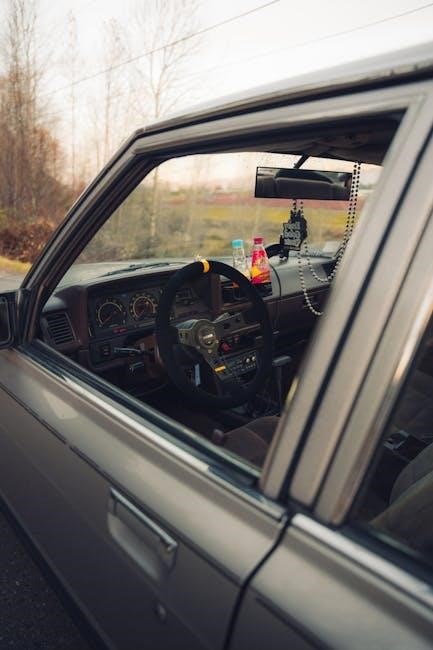2008 Toyota Highlander Owners Manual: Article Plan
Discover comprehensive PDF resources for your 2008 Highlander, including detailed maintenance, operation guides, and safety precautions. Explore available languages and supplemental information!

The 2008 Toyota Highlander represents a versatile and reliable choice within the mid-size SUV segment. Known for its comfortable ride, spacious interior, and available third-row seating, it catered to families and individuals seeking practicality and dependability. This vehicle offered a blend of car-like handling and SUV capability, making it suitable for both daily commutes and weekend adventures.

Understanding your Highlander is paramount to enjoying its full potential and ensuring its longevity. This guide serves as an essential companion, providing detailed insights into its features, operation, and maintenance. Whether you’re a first-time owner or a seasoned Highlander enthusiast, accessing the owners manual – often available as a free PDF download – is crucial.

Available in both standard and hybrid configurations, the 2008 Highlander offered buyers options to suit their needs. Resources like online forums and dedicated Toyota websites can further enhance your ownership experience, offering troubleshooting tips and community support.
Locating the 2008 Highlander Owners Manual
Finding your 2008 Toyota Highlander owners manual is easier than ever. Toyota provides several avenues for access. Firstly, a physical copy was originally included with your vehicle upon purchase. However, if misplaced, digital versions are readily available online. Official Toyota websites offer downloadable PDF versions of the manual, categorized by year and model – specifically, OM48851U and OM48690U are relevant codes.
Numerous third-party websites also host these manuals for free viewing and download. A quick internet search for “2008 Toyota Highlander owners manual PDF” will yield numerous results. Be cautious when downloading from unofficial sources to ensure file safety.
Additionally, some online platforms allow you to view the manual directly in your browser. Remember to select the correct manual version based on your Highlander’s specific trim level and options for the most accurate information. Supplemental manuals may also be available.
Understanding the Vehicle Identification Number (VIN)
Your 2008 Toyota Highlander’s Vehicle Identification Number (VIN) is a unique 17-character code crucial for identifying your specific vehicle. It’s essential for accessing accurate information related to your Highlander, including warranty details, recall notices, and correct owners manual specifications. Locate the VIN on the driver’s side dashboard near the windshield, on your vehicle registration, and insurance documents.
The VIN isn’t just a random string; each character holds specific information about your Highlander’s origin, manufacturer, model year, and assembly plant. When searching for parts or referencing the owners manual, using the VIN ensures you’re getting information tailored to your vehicle.
Toyota utilizes the VIN to track vehicle history and provide accurate service records. Understanding your VIN empowers you to verify vehicle history reports and confirm the authenticity of your Highlander. It’s a key component in responsible vehicle ownership.
Safety Precautions and Warnings
Prioritizing safety is paramount when operating your 2008 Toyota Highlander. This vehicle incorporates numerous safety features, but responsible driving habits and adherence to warnings are crucial. Always wear seatbelts, and ensure all passengers are properly restrained. Never operate the vehicle under the influence of alcohol or drugs.
The owners manual details critical warnings regarding airbags, child safety seats, and tire pressure. Pay close attention to dashboard indicators and heed any alerts regarding potential mechanical issues. Regularly inspect tires for wear and maintain proper inflation levels.
Be aware of the vehicle’s limitations and avoid aggressive driving maneuvers. Understand the operation of safety systems like ABS and traction control. Familiarize yourself with emergency procedures, including how to safely handle a tire blowout or brake failure. Your safety, and the safety of others, depends on it.
Key Features and Overview

The 2008 Toyota Highlander offers a versatile blend of comfort, space, and reliability. This mid-size SUV typically seats up to seven passengers, making it ideal for families. Key features include available all-wheel drive for enhanced traction, a powerful V6 engine option, and a spacious cargo area. Owners will appreciate the comfortable ride quality and user-friendly controls.
Standard equipment often includes air conditioning, power windows and locks, and an audio system. Higher trims may add features like leather upholstery, a sunroof, and advanced audio systems. The Highlander is known for its strong safety ratings and dependable performance.
Accessing the owners manual provides detailed information on all features and functionalities. Understanding these features will maximize your driving experience and ensure proper vehicle maintenance. Explore the various options to tailor the Highlander to your specific needs.
Dashboard Symbols and Indicators
The 2008 Toyota Highlander’s dashboard features a variety of symbols and indicators crucial for monitoring vehicle health and operation. Understanding these alerts is vital for safe driving. Key indicators include the check engine light, oil pressure warning, and battery warning light – signaling potential mechanical issues.
Safety-related symbols, such as the ABS warning and airbag indicator, alert drivers to system malfunctions. Other important indicators include the seatbelt reminder, low fuel warning, and high beam indicator. Refer to your owners manual for a comprehensive explanation of each symbol.
Pay close attention to illuminated symbols and consult the manual for recommended actions. Ignoring warning lights can lead to more significant problems. Familiarize yourself with these indicators to ensure a safe and informed driving experience.
Operation of Vehicle Controls
Mastering the 2008 Toyota Highlander’s controls ensures a comfortable and safe driving experience. This section details the operation of essential features, beginning with the steering wheel controls for audio and cruise control. Learn to adjust these settings for personalized convenience.
The climate control system allows for precise temperature adjustments, fan speed control, and air distribution. Understand how to utilize the heating, ventilation, and air conditioning functions effectively. The audio system offers various source options, including AM/FM radio, CD player, and auxiliary input.
Familiarize yourself with the location and function of all controls, including lights, wipers, and power windows. Refer to your owners manual for detailed instructions and diagrams. Proper operation of these controls enhances both safety and enjoyment while driving.
Steering Wheel Controls
The 2008 Toyota Highlander features integrated controls on the steering wheel for enhanced convenience and safety. These controls primarily manage the audio system and cruise control functions, allowing drivers to adjust settings without removing their hands from the wheel; Audio controls typically include volume adjustment, track selection, and source switching.
Cruise control operation involves setting and adjusting the desired speed, as well as canceling the system. Refer to your owners manual for specific button layouts and functionalities, as variations may exist based on trim level. Understanding these controls minimizes driver distraction and promotes a more focused driving experience.
Proper use of steering wheel controls contributes to safer operation. Familiarize yourself with the location and function of each button before driving. Regular practice will ensure quick and intuitive adjustments while on the road.
Climate Control System
The 2008 Toyota Highlander’s climate control system provides heating, ventilation, and air conditioning for passenger comfort. Systems range from manual controls to automatic climate control, depending on the trim level. Manual systems require the driver to adjust fan speed, temperature, and airflow direction. Automatic systems maintain a set temperature automatically.
Key features include dual-zone climate control in higher trims, allowing separate temperature settings for driver and passenger. Air conditioning functionality provides cooling, while the heating system ensures warmth during colder months. Proper operation involves understanding the various buttons and settings.
Refer to your owners manual for detailed instructions on using the climate control system effectively. Regular maintenance of the system, including filter replacement, is crucial for optimal performance and air quality.

Audio System Operation
The 2008 Toyota Highlander’s audio system offers various functionalities for entertainment during your drive. Systems typically include an AM/FM radio, a CD player, and potentially an auxiliary input jack for connecting external devices. Higher trims may feature a premium sound system with more speakers and enhanced audio quality.
Operation involves using the head unit’s buttons and knobs to adjust volume, tune into stations, select audio sources, and manage CD playback. Some models include steering wheel-mounted audio controls for convenient operation while driving. Understanding the system’s features, like preset station memory, is key.

Consult your owners manual for specific instructions on utilizing all the audio system’s capabilities. Proper use ensures an enjoyable listening experience. Troubleshooting common issues, like sound distortion, can also be found within the manual.

Maintenance Schedule and Procedures
Maintaining your 2008 Toyota Highlander is crucial for its longevity and performance. The owners manual details a comprehensive maintenance schedule, outlining procedures for various mileage intervals. Regular checks include oil and filter changes, tire rotations, fluid level inspections (coolant, brake, power steering), and air filter replacements.
Specific procedures are outlined for inspecting belts, hoses, and the exhaust system. More extensive services, like spark plug replacement and timing belt inspection, are scheduled at higher mileage points. Adhering to this schedule helps prevent costly repairs and ensures optimal vehicle operation;
The manual also provides guidance on performing some basic maintenance tasks yourself, while recommending professional service for more complex procedures. Following the recommended schedule, detailed in your 2008 Highlander’s manual, is vital for a reliable vehicle.
Fluid Specifications and Capacities
Ensuring the correct fluids are used in your 2008 Toyota Highlander is paramount for optimal performance and preventing damage. The owners manual meticulously lists the specified types and capacities for all essential fluids. This includes engine oil (weight and grade), coolant (type and mixing ratio), brake fluid (DOT specification), power steering fluid, transmission fluid, and transfer case fluid (if applicable).
Capacities are provided for each system, detailing the amount of fluid required during refills or replacements. Using the incorrect fluid can lead to component failure and void warranty coverage. Refer to the manual for precise specifications, as variations may exist based on engine type or optional equipment.
Always double-check fluid levels regularly and top off as needed, using only the recommended fluids detailed within your 2008 Highlander’s official documentation.
Tire Information and Maintenance
Maintaining proper tire condition is crucial for safety, handling, and fuel efficiency in your 2008 Toyota Highlander. The owners manual provides vital information regarding original tire size, recommended inflation pressures (both front and rear), and load capacity. It also details the tire pressure monitoring system (TPMS), if equipped, and how to interpret warning lights.
Regular tire inspections are essential, checking for wear patterns, damage, and adequate tread depth. The manual outlines proper tire rotation procedures to promote even wear and extend tire life. Information on understanding the tire sidewall markings, including DOT codes for age identification, is also included.
Always adhere to the recommended tire pressures and replace tires when they reach the wear bars, ensuring optimal performance and safety for your Highlander.
Troubleshooting Common Issues
The 2008 Toyota Highlander owners manual offers guidance on addressing frequently encountered problems. It details basic troubleshooting steps for issues like a vehicle that won’t start, warning light illumination, and unusual noises. The manual explains how to check fuses, jump-start the vehicle, and identify potential causes for common malfunctions.
While not a substitute for professional diagnosis, the manual provides initial steps to assess problems before seeking service. It may include information on resetting certain systems or performing simple checks. Owners can find guidance on addressing minor issues themselves, potentially saving time and expense.
Remember to consult a qualified technician for complex repairs or if you are uncomfortable performing any troubleshooting steps outlined in the manual.

2008 Highlander Hybrid System (If Applicable)
For 2008 Toyota Highlander Hybrid owners, a dedicated section within the owner’s manual details the intricacies of the hybrid powertrain. This section explains the interaction between the gasoline engine and electric motors, outlining how the system optimizes fuel efficiency and reduces emissions. It covers specific indicators related to the hybrid system, such as the hybrid system readiness indicator and charge/discharge levels.
The manual provides guidance on understanding the unique driving characteristics of a hybrid vehicle, including regenerative braking and electric-only operation. It also details specific maintenance requirements for the hybrid components, ensuring optimal performance and longevity. Owners will find information on battery care and potential warning signs related to the hybrid system’s functionality.
Towing Capacity and Procedures
The 2008 Toyota Highlander owner’s manual provides crucial information regarding towing capacity, which varies depending on the engine and drivetrain configuration. It details the maximum weight that can be safely towed, along with guidelines for selecting the appropriate trailer hitch and wiring harness. Owners are advised to consult the manual for specific weight limits and recommendations.
Proper towing procedures are thoroughly explained, including instructions for loading the trailer correctly to maintain vehicle stability. The manual emphasizes the importance of adjusting tire pressure and transmission settings when towing. It also highlights safety precautions, such as reducing speed and increasing following distance. Supplemental information regarding retightening fixing bolts is included, alongside language-specific guides for international owners.
Warranty Information
The 2008 Toyota Highlander’s original warranty coverage details are outlined within the owner’s manual, though much of this coverage may have expired. The manual typically includes information on the basic warranty, powertrain warranty, and emissions warranty, specifying the duration and coverage scope for each. Owners should review these details to understand any remaining protection.
Information regarding transferability of the warranty to subsequent owners is also provided. The manual clarifies the process for filing a warranty claim, including required documentation and authorized Toyota service centers. It’s important to note that aftermarket modifications can potentially void warranty coverage, so owners should consult the manual for specifics. Supplemental materials may offer details in various languages, ensuring accessibility for a diverse owner base.

Supplemental Information & Languages
The 2008 Toyota Highlander owners manual was thoughtfully translated into numerous languages to cater to a diverse customer base. Available languages included Thai (2008), Tigrinya (2009), Turkmen (2011), Tagalog (2012), Setswana (2014), and Tonga (2015), demonstrating Toyota’s commitment to inclusivity. Supplemental materials often address specific regional requirements or provide expanded explanations of complex features.
These resources can be invaluable for owners who prefer to read the manual in their native language or require clarification on particular aspects of vehicle operation. Owners Manual Supplements often detail towing procedures and related safety information. Accessing these supplemental documents can enhance the overall ownership experience and ensure a thorough understanding of the vehicle’s capabilities and limitations. Digital versions may be available for download.
Where to Find Additional Resources
Locating resources for your 2008 Toyota Highlander is straightforward. Official Toyota websites offer downloadable PDF versions of the owners manual, providing detailed technical information on operation and maintenance. Various online platforms host these manuals, allowing free viewing and download. Community forums dedicated to the Highlander are excellent sources for troubleshooting common issues and sharing experiences.
Consider exploring Toyota’s customer service channels for direct assistance. Websites dedicated to automotive manuals often compile resources for various models, including the 2008 Highlander. If you have a question about the main features, refer to the indicators section within the owners manual. Uploading and sharing manuals contributes to a collaborative knowledge base. Remember to verify the source’s reliability before downloading any files.
